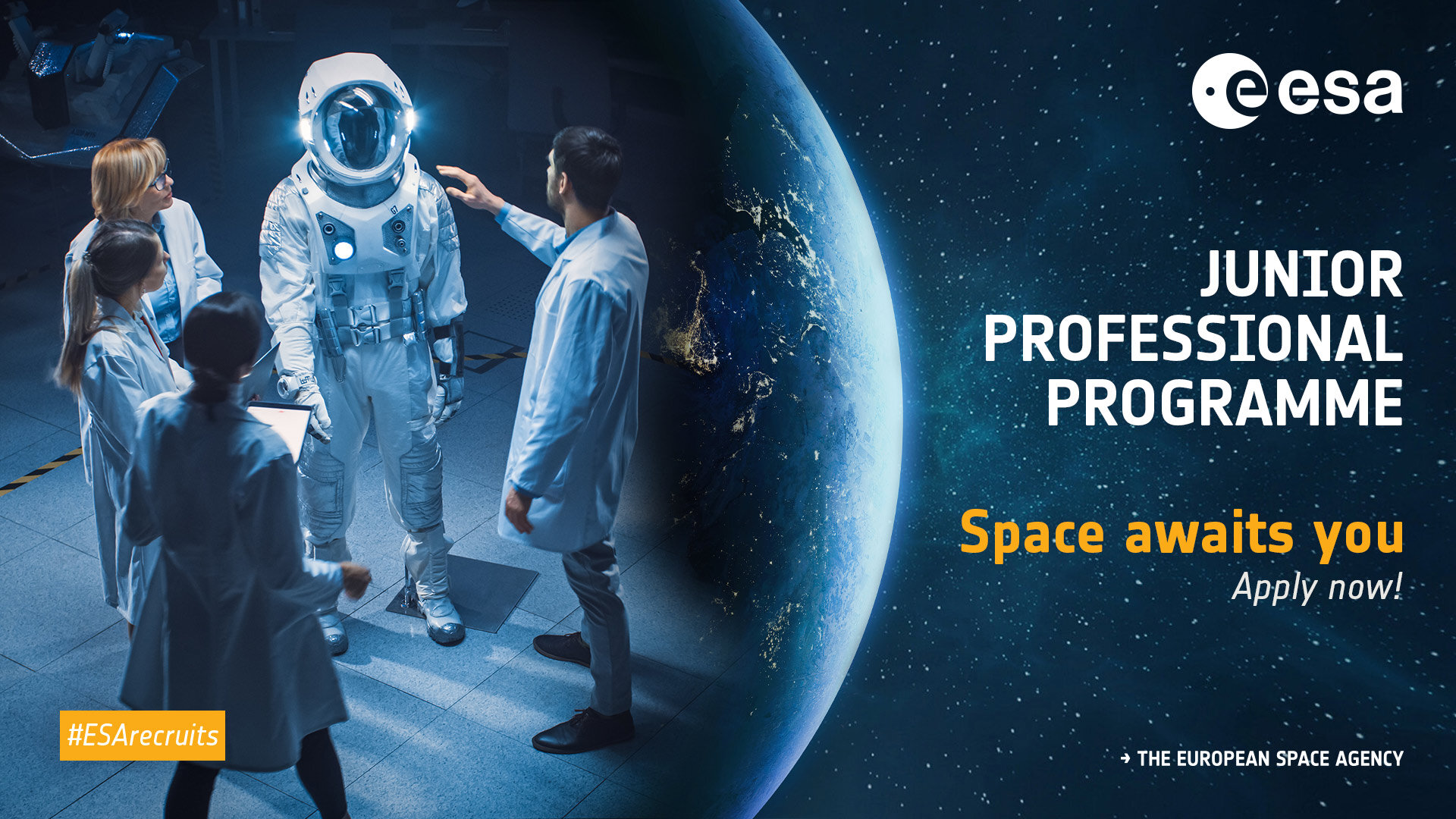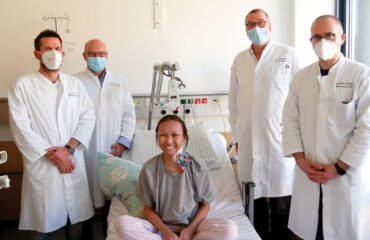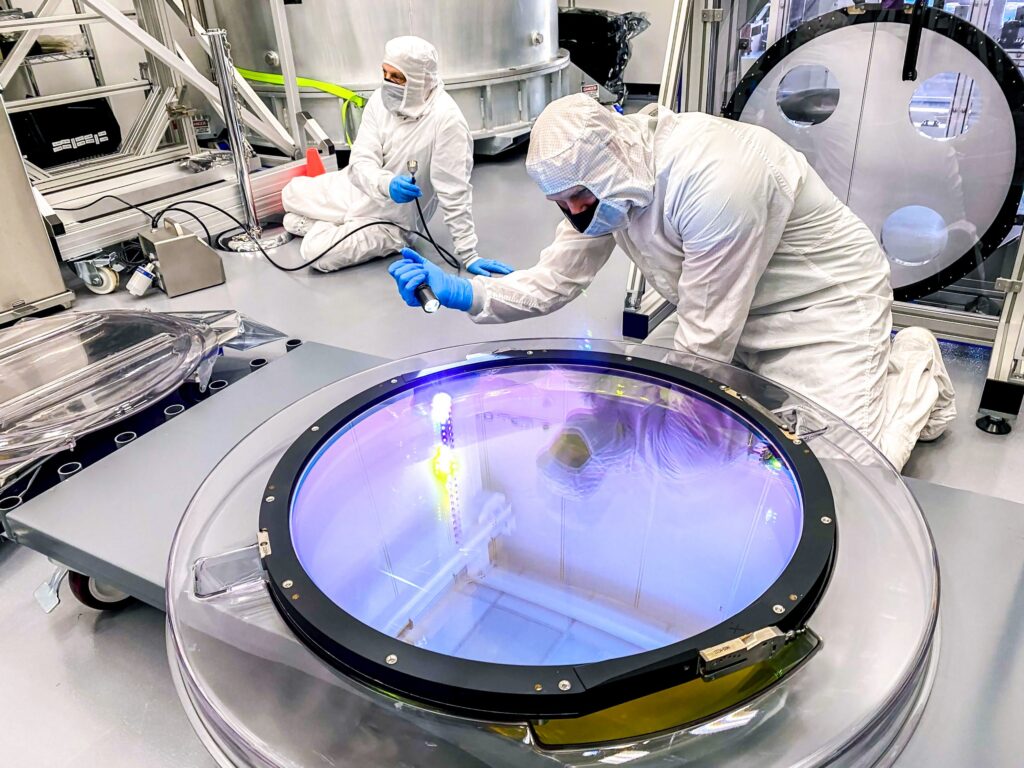
One of the six huge filters for the Vera C. Rubin Observatory LSST Camera being inspected at SLAC National Accelerator Laboratory. Image: Travis Lange/SLAC National Accelerator Laboratory
By James Myers and Mariana Meneses
There is a rapidly increasing variety of work available for space-based careers. The role of astronaut might come to mind first, but astronauts aren’t the only space explorers. Rapid technological advancements have led to many innovations in equipment and methods for learning about the cosmos, which has opened a wide range of career possibilities for skilled workers and students.
An astronaut’s work isn’t possible without aerospace technologists and technicians who, along with engineers, design, build, and maintain spacecraft systems and instruments. Health science experts provide astronauts with clinical support and conduct research on how space affects bodily functions and living organisms. Space exploration is also performed without human crews, by space and planetary probes like the various Mars rovers that require robotics experts to create and remotely control automated devices.
Astronomers operate telescopes located on Earth and, like the James Webb Space Telescope, in space, to scan the cosmos and, together with astrophysicists, analyze the vast amounts of data that the telescopes provide. Computer scientists and software developers are increasingly involved in data analysis, which has been enhanced by AI and machine learning.
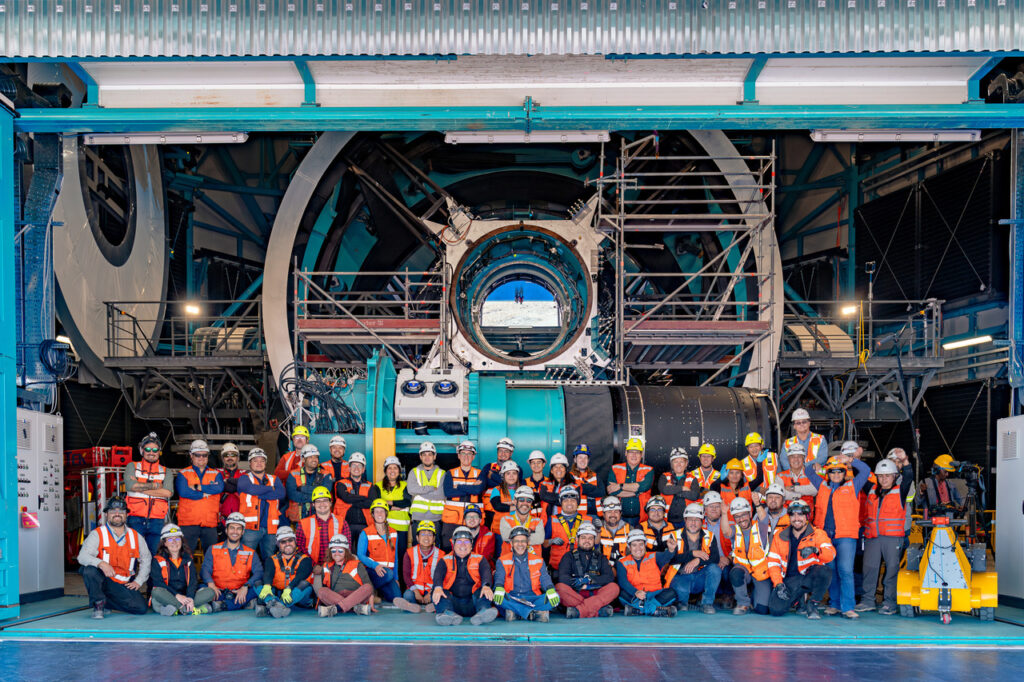
A large team is working to complete construction of the Vera C. Rubin Observatory, which will be at the forefront of the world’s astronomy facilities. Image: Vera C. Rubin Observatory.
The expansion of astronomy as a scientific field has paralleled the growth of international collaboration.
The International Astronomical Union (IAU), founded in 1919 and headquartered in Paris, now includes 85 national members and over 12,000 individual members across 90 countries and territories. It serves not only as a forum for scientific exchange through conferences but also as a key player in standardizing astronomical practices and naming conventions. Organizations like the IAU reflect how astronomy has become a globally coordinated effort, uniting experts and institutions to push the boundaries of cosmic knowledge.
hat
Katherine Johnson (1918-2020) was a groundbreaking mathematician at NASA. In an era of racial segregation and when few women worked in scientific fields, Johnson pioneered the use of computers at NASA. Her work was popularized in the 2016 movie “Hidden Figures.” Image: NASA.
The field of astronomy itself is remarkably diverse, encompassing many specialized branches. For example, Astrophysicists investigate the physical behavior of celestial bodies, while cosmologists seek to understand the origin and evolution of the universe. Astrochemists study the molecular makeup of interstellar matter, and astrobiologistssearch for signs of life beyond Earth. Each of these subfields contributes essential insights, and together they support a vast ecosystem of careers—from laboratory-based researchers to field scientists developing the next generation of observatories.
Physicists and mathematicians are essential for interpreting astronomical data, and their theoretical knowledge is crucial for the design of experiments and technologies that continue to extend humanity’s reach into the cosmos. A notable early example of mathematical contribution to space flight and technology was that of Katherine Johnson, a NASA employee whose calculations of orbital mechanics were critical to the success of the first and subsequent U.S. crewed spaceflights. In the era before today’s powerful computers, Johnson calculated the trajectory for the 1961 space flight of Alan Shepard, the first American in space.
Space careers aren’t limited to outer space exploration. For example, a range of skills is required to build and manage Earth-orbiting satellites that provide crucial communication and internet connectivity to billions of people, as well as data for air, land, and sea navigation and monitoring of weather and ground conditions around the globe. Satellite data is used by atmospheric andresearch scientists, in addition to an array of commercial and military consumers.
Ground-based space exploration is expanding around the globe.
According to National Geographic, since the 1950s more than 200 space probes have been launched to explore celestial bodies, from the Moon to comets and nearly every planet in the solar system. The number of launches continues to accelerate as more countries develop and expand their space programs and employ many people and skills for ground-based probe control.
Since they operate in extreme and varied environments, probes must be engineered with durability and precision – a task that brings together experts in robotics, programming, astrophysics, and materials science. These remotely piloted devices are equipped with specialized instruments designed to gather data about distant atmospheres, surfaces, and compositions. Depending on their missions, probes may orbit a planet, land on it, or travel far beyond our solar system, transmitting valuable scientific information back to Earth.
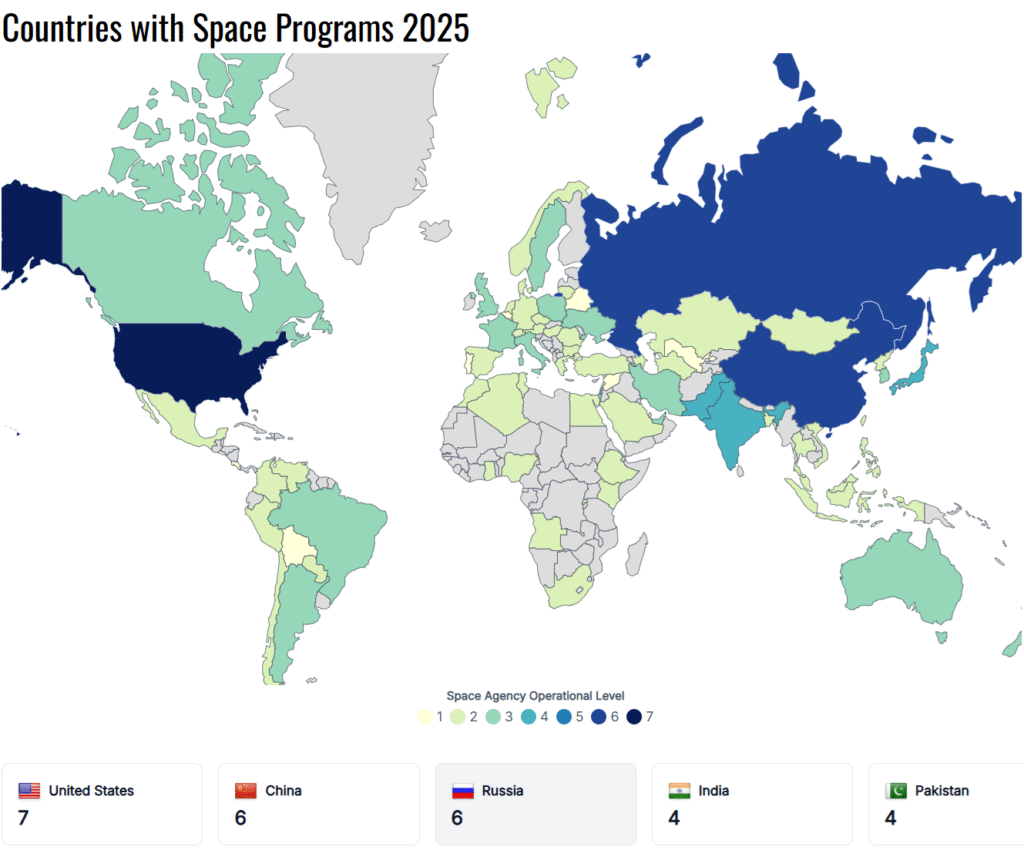
In this graphic, darker colours indicate countries with increasingly sophisticated space programs. Countries with no space program are shown in grey. Credit: World Population Review
CNN Science notes that even decades after launch, some space probes continue to deliver groundbreaking data.
NASA’s twin Voyager spacecraft, launched in 1977, are now more than 13 billion miles from Earth and have entered interstellar space—Voyager 1 since 2012 and Voyager 2 since 2018. Despite their age and gradually declining power supplies, engineers have managed to keep key instruments running by selectively shutting others down. Thanks to this careful management, both probes still transmit valuable scientific information from beyond the heliosphere, offering rare insights into the outermost reaches of our solar system nearly fifty years after their journey began.
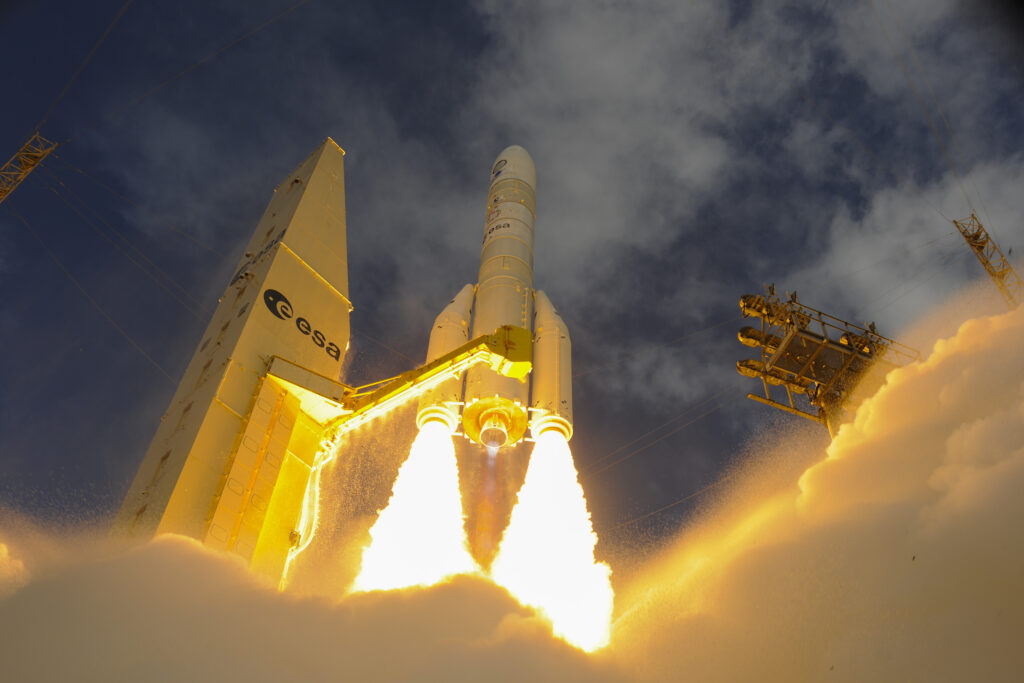
The European Space Agency’s Ariane 6 rocket takes flight on July 9, 2024. Its predecessor, the Ariane 5, was used to launch the James Webb Space Telescope in 2021. Image: European Space Agency.
According to World Population Review, space exploration is a global endeavour, led by agencies with international reach and influence.
The European Space Agency (ESA) is an alliance of 22 member states, along with associate and cooperative partners. Headquartered in Paris, it also operates offices across Europe and in countries like the United States and Russia. The United States’ NASA remains the most active and well-funded space agency, with a budget nearly double that of any other. These institutions not only lead missions but also provide thousands of jobs for scientists, engineers, and administrators around the world.
One of the most transformative tools in this new era of space science is the James Webb Space Telescope (JWST). As MIT Technology Review highlights, JWST has exceeded expectations, collecting more than 50 gigabytes of data per day—far outpacing its predecessor, the Hubble. Thanks to advanced algorithms and open-access policies, this data is rapidly analyzed and has already produced extraordinary findings: carbon dioxide in exoplanet atmospheres, ancient galaxies from the early universe, and more. The pace and volume of discoveries are reshaping astronomy, calling for ever more collaboration between astronomers, data scientists, and AI specialists.
Training for space careers is now mainstream.

On September 12, 1962, U.S. President John Kennedy delivered his “moonshot” speech. Kennedy’s words ignited American passion and industry for space exploration: “We choose to go to the Moon in this decade and do the other things, not because they are easy, but because they are hard; because that goal will serve to organize and measure the best of our energies and skills, because that challenge is one that we are willing to accept, one we are unwilling to postpone, and one we intend to win, and the others, too. Image: Wikipedia.
When space technologies first began to appear during the Cold War era that followed the Second World War 80 years ago, training options were limited and relied primarily on government funding by agencies like NASA and the U.S. Department of Defense. Space career training is now widely available and is part of the mainstream curricula of many universities and colleges.
The major impetus for the growth of space careers was the Cold War rivalry between the United States and Soviet Union in a “space race,” with each superpower aiming to exceed the crewed and uncrewed space flight capability of the other. The race heated up in 1957, when the Soviets were the first to put a satellite in Earth orbit, and five years later U.S. President John Kennedy announced, to a stadium audience of 40,000 people, America’s intention to put a man on the Moon.
A short seven years later, the U.S. successfully landed humans on the Moon, after a monumental effort and investment that placed space and its industrial possibilities firmly in the human imagination. Exploring space is now a global endeavour, with the direct involvement of space programs in 77 nations, of which at least 16 space agencies are capable of completing space launches. In the US, there has been a 300% increase in the number of astronomy bachelor degrees awarded in 2023, compared to 2009.
Universities are building programs to provide students with training and hands-on experience for space careers. The University of British Columbia provides one example with its Orbit Satellite Design Team, a multi-disciplinary collaboration of physicists, engineers, computer scientists, and others, with several projects underway. One of Orbit’s current projects is called ALEASAT, in which students are helping to build an Earth-observation satellite and the ground station infrastructure that will allow radio amateurs to assist in disaster relief operations.
The range and number of space career options continues to expand rapidly.
The Space Report 2024 Q1 highlights a significant growth in the U.S. private space workforce in 2023: “The number of private sector space workers in the United States jumped 4.8% in 2023, with a strong employment forecast for the sector promising more work ahead, especially in the growing commercial space market. Total employment in the U.S. space sector, including NASA employment and military roles, grew to 222,300 positions from 201,000 in 2022.”
In addition, there was a record-setting launch rate in early 2024, with 41 rocket launches in the first two months alone. Despite an uptick in lost payloads, failure rates remain steady. Government budget freezes signal a shift toward commercial partnerships, even as geopolitical tensions rise. Meanwhile, rapid satellite deployment, growing commercial satellite constellations like those of SpaceX (which had 5,500 satellites in orbit at the beginning of 2024), and space-enabled medical innovations underscore a booming and diversifying global space sector.
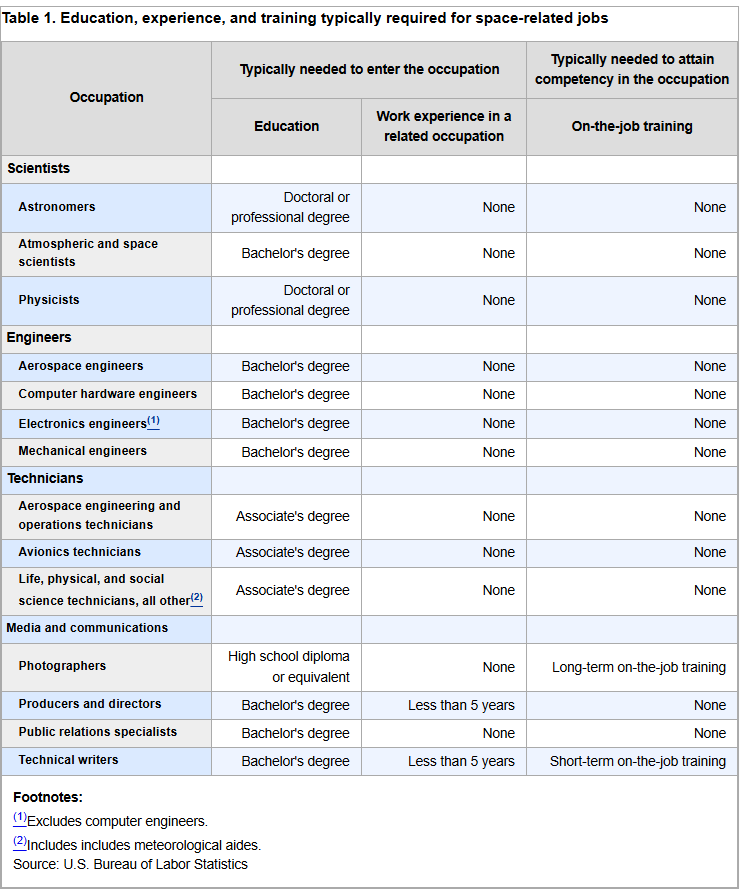
Credit: U.S. Bureau of Labor Statistics
Recruiting for space careers is an expanding industry.
For early-career professionals looking to enter the space field, structured pathways are becoming more accessible. For example, the European Space Agency offers the Junior Professional Programme (JPP), targeting master’s degree graduates with two to three years of work experience. Participants join ESA as staff members for a four-year term, during which they receive tailored training and development aimed at preparing them for long-term roles within the agency. Starting this year, ESA is offering 15 such positions annually, providing a valuable launchpad for those eager to shape the future of space in Europe.
The private sector is also reshaping the landscape of space careers.
Companies like SpaceX and Blue Origin are aggressively hiring, and their competition for skilled workers drives up salaries and offers employees the allure of fast-paced innovation.
While these newer companies promise excitement and ambitious missions, they also come with demanding workloads and high turnover. The US government’s space agency NASA, and firms like Boeing that have long been in the space business, face challenges in retaining top talent, relying instead on their reputation for stability, long-term benefits, and work-life balance. Across the sector, recruitment is expanding through partnerships with universities, internships, scholarships, and mentorship programs—vital strategies for building a strong pipeline of future professionals.
According to Space Insider, the diversity of private space companies reflects the expanding frontiers of space exploration and commercialization. For example, Japan-based ispace is fully focused on the Moon, aiming to land, explore, and eventually establish a permanent human presence. Astroscale, also headquartered in Tokyo, is working to extend the lifespan of satellites and remove space debris from Earth’s orbit.
Meanwhile, U.S.-based startups like AstroForge, with its sights set on asteroid mining, and Orbit Fab, which is developing orbital refuelling stations—“gas stations in space” – are working to create industry and supporting infrastructure in space. Others, like Israel-based SpacePharma, enable scientific experiments in microgravity through space-based research platforms. Each of these ventures contributes to a rapidly evolving ecosystem that calls for specialized talent in engineering, logistics, research, and beyond.
The number of businesses in the space recruiting industry is also increasing, with companies like Space-Recruit, MDA Space, Evona, and Space Crew – the latter boasts “the solar system’s biggest space job site.” Startups like the Space Career Academy offer skill development courses, career guidance and placement, and support to entrepreneurs. The Space Career Academy foresees a future in the space industry for an even wider range of skills, including artists and designers to support space tourism, psychologists and wellness experts to support human adaptation to space, and culinary scientists to design life-sustaining nourishment for space explorers and tourists.
As space exploration expands across sectors and disciplines, so do its career paths. From astronomy and engineering to wellness, design, and entrepreneurship, the space economy is becoming as diverse as the universe it studies. With industry and education increasingly aligned, the next generation of space professionals is already on its way.
Craving more information? Check out these recommended TQR articles:
- Thinking in the Age of Machines: Global IQ Decline and the Rise of AI-Assisted Thinking
- Everything Has a Beginning and End, Right? Physicist Says No, With Profound Consequences for Measuring Quantum Interactions
- Cleaning the Mirror: Increasing Concerns Over Data Quality, Distortion, and Decision-Making
- Not a Straight Line: What Ancient DNA Is Teaching Us About Migration, Contact, and Being Human
- Digital Sovereignty: Cutting Dependence on Dominant Tech Companies

